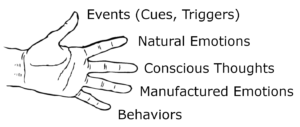Every interaction we have with the universe, whether with people, animals, objects, or even our own thoughts or bodily sensations, has five elements. I like to represent these with my hand. It has the advantage of being concrete, as well as portable. My clients often tell me they find themselves looking at their hands when trying to figure out their own or others’ responses!
 Events do not cause our behaviors, but they can be said to “trigger” or “cue” them. Internal events include bodily sensations, such as a growling stomach or full bladder, or thoughts, or even emotions. External events are those that are potentially observable by others, such as a traffic light turning yellow or red. We are not always consciously aware of the events to which we or other people respond. Our conscious minds sometimes miss things to which our subconscious minds respond strongly. As a result, we are often mystified by our own behaviors!
Events do not cause our behaviors, but they can be said to “trigger” or “cue” them. Internal events include bodily sensations, such as a growling stomach or full bladder, or thoughts, or even emotions. External events are those that are potentially observable by others, such as a traffic light turning yellow or red. We are not always consciously aware of the events to which we or other people respond. Our conscious minds sometimes miss things to which our subconscious minds respond strongly. As a result, we are often mystified by our own behaviors!
 Natural Emotions are our immediate responses to events. They are not mediated by conscious thoughts, but arise from the subconscious or emotional mind. The subconscious lies under the surface of our conscious awareness, which is why it is often represented by an iceberg. It is devoted almost entirely to our minute-by-minute survival, continuously monitoring our internal and external environments and estimating our energy needs. If the subconscious concludes we are in danger, it may trigger the release of stress hormones such as adrenaline and cortisol commonly known as the “fight or flight reaction. Note that cortisol triggers a “dump” of glucose (sugar) into the bloodstream, to prepare us to fight or flee. This is part of the reason chronic stress can contribute to obesity and diabetes!
Natural Emotions are our immediate responses to events. They are not mediated by conscious thoughts, but arise from the subconscious or emotional mind. The subconscious lies under the surface of our conscious awareness, which is why it is often represented by an iceberg. It is devoted almost entirely to our minute-by-minute survival, continuously monitoring our internal and external environments and estimating our energy needs. If the subconscious concludes we are in danger, it may trigger the release of stress hormones such as adrenaline and cortisol commonly known as the “fight or flight reaction. Note that cortisol triggers a “dump” of glucose (sugar) into the bloodstream, to prepare us to fight or flee. This is part of the reason chronic stress can contribute to obesity and diabetes!
The subconscious mind learns slowly, but it learns well. It is the home of our emotions, and of our habits. It is very efficient, and enables us to live our day-to-day lives with little conscious thought or awareness. Of course, those same habits can become problematic for us. This is why, when explaining all of this to children, I often call the subconscious mind “the stupid brain!”
Thoughts are products of the conscious mind, which is slightly slower than the subconscious. When we say we “know” something, we are generally talking about the conscious mind. We have the absolute ability to change our conscious thoughts, but this requires attention, concentration and effort. This is what we mean when we refer to “mindfulness,” which is the practice of purposely bringing one’s attention in the present moment without judgment. Many of the things we do that are bad for us are done “mindlessly.” If we took a moment to think about it, we might not light that cigarette or take that drink or eat that glazed donut. Unfortunately though, those habitual behaviors are typically under the control of the “stupid brain!”
Manufactured Emotions are products of our thoughts. Like other manufactured things, they are still “real,” though they are mediated by our thoughts. Our manufactured emotions are at least partially limited and controlled by our “emotional palettes.” Just as a painter cannot use colors that are not on his palette, we cannot experience emotions that are outside our experience. If we grew up in a happy home, we are more likely to experience happy emotions. On the other hand, a person who had depressed or anxious or abusive parents is more likely to experience those more negative emotions. The great thing, though, is that we do not have to be victims of our childhoods. We can always give ourselves new experiences, leading to larger palettes and greater choices. Because we manufacture them, we can choose our emotions!
Behaviors are our responses to events, natural emotions, thoughts and manufactured emotions. As I said above, we are often mystified by our own behaviors; especially if we have experienced childhood trauma or other events that have loaded our subconscious minds with lots of fears, anxiety and anger.
I call myself a “cognitive behavior therapist” because of the five elements listed above, only our thoughts and our behaviors are under our conscious control.
We might be able to change the events in our lives, and I often encourage people to do just that, by avoiding people, places and activities that have been known to cue problematic behaviors in the past. But this is not always possible. For example, if one of your “triggers” is your boss or one of your teachers, you may not be able to change that.
You cannot directly change your subconscious mind. You might be able to influence it, though that will take a good deal of time and effort. After all, your subconscious mind has been programmed by all of the experiences you have had over the course of your life (including in utero). It may not take that long to change your subconscious mind, but it will surely take more than a day or a week or even a month!
But we can simply decide to think different conscious thoughts. If we practice consistently enough, over a long enough time, we can influence our subconscious minds.
We can also learn new and different emotions, which can change our manufactured emotions. I have seen people retrain themselves, for example, to be “optimistic” instead of “pessimistic.” These are not character traits: they are just habits of thought. And we can always learn new habits!
Finally, we have total control over our behaviors. We do not have to act on our impulses or emotions. For example, we often smile when we feel sad or angry. We can choose to walk past the pastry table when we feel hungry. We can control the impulse to light a cigarette or take a drink when we feel anxious. We can even force ourselves out of bed in the morning, even though it is raining and we don’t feel like going for our morning walk. All of these things are under our control, if we are sufficiently deliberate about making conscious choices instead of being slaves to our bad habits.

1 Comment
Vonda Smith · February 20, 2021 at 2:27 pm
John,
Your model is the first I remember seeing with the natural emotions recognized and separated from manufactured ones (a term I had not heard before you originally shared your model with me.) I think it is an important distinction that provides CBT with the piece I have always felt was missing; recognition of the immediate emotional responses to events that are triggered before any thoughts actually occur.